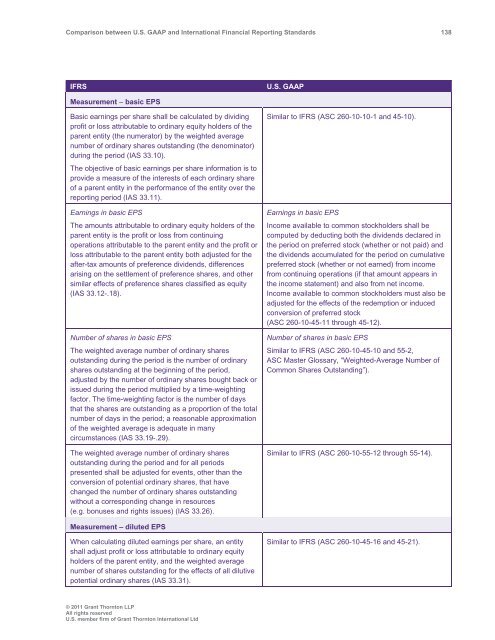Comparison between U.S. GAAP and International ... - Grant Thornton
Comparison between U.S. GAAP and International ... - Grant Thornton
Comparison between U.S. GAAP and International ... - Grant Thornton
You also want an ePaper? Increase the reach of your titles
YUMPU automatically turns print PDFs into web optimized ePapers that Google loves.
<strong>Comparison</strong> <strong>between</strong> U.S. <strong>GAAP</strong> <strong>and</strong> <strong>International</strong> Financial Reporting St<strong>and</strong>ards 138<br />
IFRS<br />
U.S. <strong>GAAP</strong><br />
Measurement basic EPS<br />
Basic earnings per share shall be calculated by dividing<br />
profit or loss attributable to ordinary equity holders of the<br />
parent entity (the numerator) by the weighted average<br />
number of ordinary shares outst<strong>and</strong>ing (the denominator)<br />
during the period (IAS 33.10).<br />
The objective of basic earnings per share information is to<br />
provide a measure of the interests of each ordinary share<br />
of a parent entity in the performance of the entity over the<br />
reporting period (IAS 33.11).<br />
Earnings in basic EPS<br />
The amounts attributable to ordinary equity holders of the<br />
parent entity is the profit or loss from continuing<br />
operations attributable to the parent entity <strong>and</strong> the profit or<br />
loss attributable to the parent entity both adjusted for the<br />
after-tax amounts of preference dividends, differences<br />
arising on the settlement of preference shares, <strong>and</strong> other<br />
similar effects of preference shares classified as equity<br />
(IAS 33.12-.18).<br />
Number of shares in basic EPS<br />
The weighted average number of ordinary shares<br />
outst<strong>and</strong>ing during the period is the number of ordinary<br />
shares outst<strong>and</strong>ing at the beginning of the period,<br />
adjusted by the number of ordinary shares bought back or<br />
issued during the period multiplied by a time-weighting<br />
factor. The time-weighting factor is the number of days<br />
that the shares are outst<strong>and</strong>ing as a proportion of the total<br />
number of days in the period; a reasonable approximation<br />
of the weighted average is adequate in many<br />
circumstances (IAS 33.19-.29).<br />
The weighted average number of ordinary shares<br />
outst<strong>and</strong>ing during the period <strong>and</strong> for all periods<br />
presented shall be adjusted for events, other than the<br />
conversion of potential ordinary shares, that have<br />
changed the number of ordinary shares outst<strong>and</strong>ing<br />
without a corresponding change in resources<br />
(e.g. bonuses <strong>and</strong> rights issues) (IAS 33.26).<br />
Similar to IFRS (ASC 260-10-10-1 <strong>and</strong> 45-10).<br />
Earnings in basic EPS<br />
Income available to common stockholders shall be<br />
computed by deducting both the dividends declared in<br />
the period on preferred stock (whether or not paid) <strong>and</strong><br />
the dividends accumulated for the period on cumulative<br />
preferred stock (whether or not earned) from income<br />
from continuing operations (if that amount appears in<br />
the income statement) <strong>and</strong> also from net income.<br />
Income available to common stockholders must also be<br />
adjusted for the effects of the redemption or induced<br />
conversion of preferred stock<br />
(ASC 260-10-45-11 through 45-12).<br />
Number of shares in basic EPS<br />
Similar to IFRS (ASC 260-10-45-10 <strong>and</strong> 55-2,<br />
ASC Master Glossary, “Weighted-Average Number of<br />
Common Shares Outst<strong>and</strong>ing”).<br />
Similar to IFRS (ASC 260-10-55-12 through 55-14).<br />
Measurement – diluted EPS<br />
When calculating diluted earnings per share, an entity<br />
shall adjust profit or loss attributable to ordinary equity<br />
holders of the parent entity, <strong>and</strong> the weighted average<br />
number of shares outst<strong>and</strong>ing for the effects of all dilutive<br />
potential ordinary shares (IAS 33.31).<br />
Similar to IFRS (ASC 260-10-45-16 <strong>and</strong> 45-21).<br />
© 2011 <strong>Grant</strong> <strong>Thornton</strong> LLP<br />
All rights reserved<br />
U.S. member firm of <strong>Grant</strong> <strong>Thornton</strong> <strong>International</strong> Ltd
















